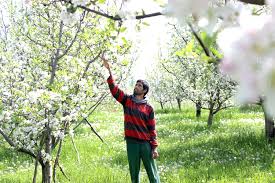Malik Zahra Khalid
 Warm winters is a new phenomenon in Kashmir valley. In February the temperature rise has been ten degrees more than normal according to meteorological department. After 76 years, Kashmir is witnessing such rise in temperatures during winter months. The warmth has rushed the spring and in the month of February there are almond blossoms. There is also activity in Badamvaer, the small grove that J&K Bank could save from Afghan Governor Waris Khan’s orchard of almonds in the foot hills of Kohi Maran.
Warm winters is a new phenomenon in Kashmir valley. In February the temperature rise has been ten degrees more than normal according to meteorological department. After 76 years, Kashmir is witnessing such rise in temperatures during winter months. The warmth has rushed the spring and in the month of February there are almond blossoms. There is also activity in Badamvaer, the small grove that J&K Bank could save from Afghan Governor Waris Khan’s orchard of almonds in the foot hills of Kohi Maran.
Temperature hike in the month of February is a dangerous siren as it has sounded the climate change in Kashmir Valley. Hot days in February after 76 years could mean that natural disasters are in the offing, preparing to strike any time. Dwindling forest cover and rapid urbanization are some of the factors for the climate change in Kashmir. The forest cover, which is about 20,200 kms at present, is less than one third of the recommended area [as per National Forest Policy, 1998].
Earlier, when some environmentalists use to warn about the climate change one of them wrote: we have to take our children to Shimla to show them snow. Today it sounds close to truth as there has been very less snowfall recorded this winter in Kashmir. Is climate change in Kashmir linked to the global warming or have we accelerated the process of destruction by our growing greed and carelessness towards environment.
Among the recurring natural disasters flash floods have already become a routine in J&K state. Mud slides in Ladakh region is a sad reminder of melting glaciers in this hilly region. Glacial melt in Himalayas, which is far more catastrophic, has a potential of bringing huge floods in the plains with Government doing very little to control such situations. In Ladakh region water level has gone down pushing Leh town to the brink of drinking water crisis.
Reduction in average snowfall in Kashmir valley does not augur well for the agriculture or horticulture sectors. The two sectors form the backbone of Kashmir’s economy and many experts have warned that March /April rains could be disastrous for both these sectors in Kashmir valley. The climate changes that are being observed in Kashmir have the potential of nurturing frustration in masses as thousands of families are yet to come out from the disastrous impacts of September 2014 deluge. Life has yet to come on track for these flood-hit families, and the planners of J&K state do not even bother to read different reports published by environmentalists about the climate change and its impact on the overall life.
Kashmir valley has a huge uncovered area in hills. Despite claims by the forest department they have yet to go for massive plantations to save the forest cover. The thin forest cover in some sensitive hilly areas has already resulted in massive soil erosion and it needs immediate attention of the government to address such problems in the hilly terrain of the state.
Crop insurance scheme announced by the central government to contain farmer suicides in various states can come handy for our state authorities to save the situation if the climate change has an adverse effect this season. In the past few years according to media reports agriculture and horticulture sectors suffered huge losses because of hail storms and untimely rains. The state government has done little to bring these sectors out of debt trap.
Researchers have already warned of more floods in J&K state as the glaciers have started melting at an alarming speed. With no fresh snowfall cover on them, snow melting will only increase in the coming summer here.
Snowfall in Kashmir used to be a treat not only for youngsters to enjoy but is looked as the bounty of God for farmers and orchard owners. With less snowfall recorded this season and unusual warming of February 2016, it has a message for the people of valley – that they should prepare themselves for more disastrous situations to face.
Author teaches at Media Education Research Centre, Kashmir University and she can be mailed at zaramlk94@gmail.com





